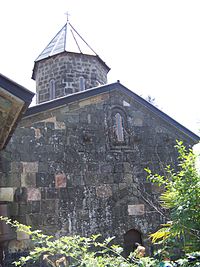Shemokmedi Monastery
| Shemokmedi Monastery | |
|---|---|
 Church inShemokmediMonastery | |
| Religion | |
| Affiliation | Georgian Orthodox Church |
| Location | |
| Location | |
| Geographic coordinates | 41°54′26″N42°3′46″E/ 41.90722°N 42.06278°E |
| Architecture | |
| Type | Monastery,church,castle |
| Style | Georgian |
 | |
TheShemokmedi monastery(Georgian:შემოქმედის მონასტერი) is aGeorgian Orthodoxmonastery located at the village ofShemokmediinGeorgia's southwestern region ofGuria.Founded in the 15th century, the Shemokmedi monastery functioned as a seat of abishopricand burial ground of theGurieliprincely dynasty. It was a safe-house of church treasures and, over the centuries, had accumulated an extensive collection of various objects from other Georgian monasteries. Parts of the collection, which survived the 19th-century robbers, are now on display in Georgia's museums.
Architecture
[edit]The Shemokmedi monastery consists of two architecturally simple churches—those of theRedeemerand theTransfigurationotherwise known as Zarzma. The third structure, a bell tower, is built upon the fence of the monastery. This complex is located on a small hill on the left bank of the Bzhuzhi river, overlooking the village of Shemokmedi.[1]
The church of the Redeemer is a three-navebasilicawith the dimensions of 10 × 13 m. It is anashlarstructure, lined withbluestone,and with a white marble floor. An ornate curving follows the contour of a window on the western façade. The interior was once entirely frescoed. The surviving fragments depict Mamia II Gurieli (died 1627), Prince of Guria, and his wife Tinatin, with respective identifying inscriptions in Georgian.[1]
The church of the Transfiguration was constructed at the behest of PrinceVakhtang I Gurieliin the late 1570s to house the venerated 9th-century Icon of the Transfiguration of Jesus rescued from theZarzma Monasteryin theOttoman-occupiedPrincipality of Samtskhe;hence comes the other name of the church, "Zarzma". This church is smaller than that of the Redeemer, with the dimensions of 9 × 7 m. It is a single-nave design crowned with an octagonal dome. The edifice is lined with brick and ashlar. Fragments of Georgian and Greek inscriptions as well as fresco depiction of the first bishop of Shemokmedi, Besarion Machutadze, survive on walls. A bell-tower built upon the church fence was originally constructed in the 16th century and renovated in 1831. All structures of the complex bare traces of multiple reconstructions.[1]
Northeast of the Shemokmedi monastery, at a distance of some 1.5 km, on the right bank of the Bzhuzhi, is the recently restored Gorisperdi church. Ornate fragments from the earlier, ruined medieval structure are found in the churchyard.[1]
History
[edit]
The Shemokmedi Monastery was founded in the 15th century as a seat of one of the three bishoprics of thePrincipality of Guria,the other two being Jumati and Khino. Local prelates bore the rank ofarchbishopormetropolitan bishopand the epithet of Shemokmedeli. At the same time, the monastery served as a burial ground to theGurieliprincely dynasty. The surviving tombs belong toRostom Gurieli(died 1564) andMamia III Gurieli(died 1714).[1]
After the death of Metropolitan Bishop Ioseb Takaishvili in 1794, the Shemokmedi sea became dormant; the bishop of Jumati became a titular Shemokmedeli, while the monastery and its possessions passed toKaikhosro Gurieli,an influential member of the ruling dynasty of Guria, who eventually lost his estates for leading an insurrection against theRussian Empirein 1820. During the conflict, Shemokmedi was stormed by the Russian troops, its fortifications were demolished and environs devastated.[2][3]
The Shemokmedi monastery was reinstated as a bishopric see, uniting the parishes ofBatumiand Shemokmedi, in 1920. The Shemokmedi Diocese was as a separateeparchywas reestablished in 1995. Currently, its jurisdiction extends to all Orthodox churches in all three municipalities of Guria—Ozurgeti,Lanchkhuti,andChokhatauri.The incumbentCatholicos Patriarch of GeorgiaIlia IIserved as Bishop of Shemokmedi from 1963 to 1967.[4]
Collections
[edit]
Over centuries, the Shemokmedi cathedral became a safe-house of ecclesiastic treasures and accumulated a large collection of various religious objects and manuscripts from other churches and monasteries of Georgia.[5][1]In 1873, the church was visited and the first scholarly description of its collection was compiled byDimitri Bakradze.Subsequently, the monastery was subjected to a series of robberies. The surviving treasures were catalogued byNikodim Kondakovon his visit to the monastery in 1889.[6]Since 1924, most of the extant items have been in the collections of theGeorgian National Museum.
Notes
[edit]- ^abcdefGamkrelidze et al. 2013,pp. 566–567.
- ^Belyavsky & Potto 1904,pp. 530–531.
- ^Rayfield 2012,pp. 276–277.
- ^"შემოქმედის ეპარქია [Shemokmedi Eparchy]"(in Georgian). Patriarchate of Georgian Orthodox Church.Retrieved3 December2016.
- ^Eastmond 2011,pp. 59, 81.
- ^Kondakov 1890,pp. 111–133.
References
[edit]- Belyavsky, N.N.; Potto, V.A., eds. (1904).Утверждение русского владычества на Кавказе[The Consolidation of Russian Dominion over the Caucasus](PDF)(in Russian). Vol. 3, Part 2. Tiflis: Caucasus Military District Staff Typography.
- Eastmond, Antony (2011). "Messages, Meanings and Metamorphoses: the Icon of the Transfiguration of Zarzma". In Lymberopoulou, Angeliki (ed.).Images of the Byzantine World — Visions, Messages and Meanings. Studies presented to Leslie Brubaker.Farnham: Ashgate. pp. 57–82.ISBN978-1409407768.
- Gamkrelidze, Gela; Mindorashvili, Davit; Bragvadze, Zurab; Kvatsadze, Marine, eds. (2013). "ციხისძირი [Tsikhisdziri]".ქართლის ცხოვრების ტოპოარქეოლოგიური ლექსიკონი[Topoarchaeological dictionary of Kartlis tskhovreba: The history of Georgia](PDF)(in Georgian) (1st ed.). Tbilisi: Georgian National Museum. pp. 588–592.ISBN978-9941-15-896-4.
- Kondakov, Nikodim (1890).Опись памятников древности в некоторых храмах и монастырях Грузии [Description of the monuments of old in some churches and monasteries of Georgia](PDF).St. Petersburg: Ministry of the Means of Communication Tiypography.
- Rayfield, Donald(2012).Edge of Empires: A History of Georgia.London: Reaktion Books.ISBN978-1780230306.




